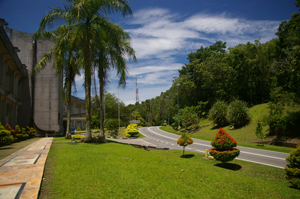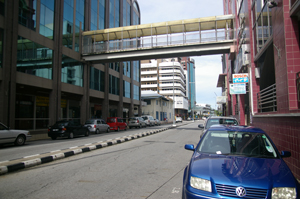 Yesterday we arrived in Brunei Darassalam. People who have heard of it know it simply as Brunei. If you haven’t heard of it, it’s a small sultanate of just over 300,000 people on the north coast of Borneo. Most of the population is Malay, with Chinese and Indian making up the balance. Malay is the official language, although people are fluent in English as well. Islam is the official religion, although all are tolerated. We stayed in the only city of any size, the capitol Bandar Seri Begawan. There’s not much to see, hence the single post on our short day and a half here. Despite its size, I thought it was interesting purely for its uniqueness. It also happens to be our twentieth country on this trip.
Yesterday we arrived in Brunei Darassalam. People who have heard of it know it simply as Brunei. If you haven’t heard of it, it’s a small sultanate of just over 300,000 people on the north coast of Borneo. Most of the population is Malay, with Chinese and Indian making up the balance. Malay is the official language, although people are fluent in English as well. Islam is the official religion, although all are tolerated. We stayed in the only city of any size, the capitol Bandar Seri Begawan. There’s not much to see, hence the single post on our short day and a half here. Despite its size, I thought it was interesting purely for its uniqueness. It also happens to be our twentieth country on this trip.
Yesterday afternoon was taken up with trying to find a place to stay and just exploring the tiny town. One of the first things we noticed is that Brunei is definitely first world. When we got to Thailand, we thought that was first world, but that was coming from South Asia. Then Malaysia was another step up, but even it is not classified as first world. Well, Brunei is and its readily apparent. The downside for us is that there’s not really any budget accommodation. Like any first world place, the only budget accommodation was a hostel. So we checked in to the Pusat Belia Youth Hostel, the only one in the small country. Being a strictly Muslim country, there were separate halls for men and women, so Joylani and I had to split for the two nights. On a similar note, the only thing the customs agent asked me when we entered the country was if I was carrying any alcohol. Although I was permitted to bring in a certain volume for personal consumption, it’s illegal to sell inside Brunei. I didn’t have any alcohol or any other controlled drugs; failure to declare controlled drugs or smuggling illegal substances carries a mandatory death sentence. On a lighter note, we met quite a few nice, older travelers at the hostel, rather than your typical backpacker hostellers. We walked around town looking for dinner, which we eventually found at a 24×7 South Indian restaurant. First impressions of Bandar was that it was really small. Modern with some nice buildings, but only a couple blocks square. The cars were mostly luxury imports and they always stopped, regardless of whether there was a green light, red light, or even a cross walk. Either they were very courteous or there’s a strict penalty for failing to stop if someone looks like they might cross the street.

Brunei is a nicely manicured place
Our first stop this morning was at the Brunei Museum. It had a range of diverse galleries, which gave us a good sense of the place: Natural History and Ecology, National History, Art, Culture, Oil and Gas, and new gallery showcasing artifacts from a recently discovered shipwreck. Ironically, there was also a traveling photo exhibit focused on Native Americans. I’ll share a little historical background of the place. The Sultanate has been around since the 14th century and it eventually expanded to control most of Borneo in addition to parts of modern-day Malaysia, Indonesia, and the Philippines. Most importantly it was the gateway to the famous Spice Islands (known as The Moluccas is modern-day Indonesia), who’s spices drove the entire trade between Europe, India, and China. (To break it down for the non-history majors out there, Europeans traded European goods to India for textiles and China for hard-goods, which in-turn they traded to South East Asia for spices which commanded astronomical prices in Europe. To tie this in to American history, it was the allure of this profit that drove a certain Italian named Christoforo Colombo sail west. Back to Europeans, they had to do it this way because there was no demand for European goods in SEA and Indian and Chinese goods were already being supplied to Europe). But Brunei’s strategic position on the trade routes made it a target of Spanish, Portuguese, and Dutch aggression though. Brunei did reach an understanding the British, although the Brits used security as an excuse to take control of large swaths of Brunei (these areas later fell into American hands, before being incorporated into the Malaysian Federation, as the states of Sarawak and Sabah). Oil began to be discovered in the late 19th and early 20th centuries, which brought a lot of British investment, most notably from the British firm Shell. Despite having profits siphoned by British Imperialism, oil began to make Brunei wealthy. Drilling was halted during the Japanese offensive and subsequent occupation, but was up and running soon after their 1945 surrender. Brunei declined to join Malaysia in 1957, in order to protect both its wealth and the sultan’s power. Instead, it remained a British territory, which gave it a certain level of autonomy, while Britain handled its security and foreign affairs. On New Years of 1984, it finally did declare its independence.
Since then, the Sultan has held the dual roles of PM and Commander-in-Chief, while his family fills other ministerial positions. In fact, half of the country is employed by the state/monarchy. The sultan was the richest man in the world at certain points during the nineteen seventies and eighties too. You would think that people would be unhappy living in an autocratic state where the head of state enriches himself with the nation’s natural resources. In fact, the opposite is true, as oil has enriched most Bruneians as well- oil wealth subsidizes everything from houses to haj trips. There’s no income taxes and gasoline is cheaper than water. People are definitely well off in Brunei. The capitol is immaculately kept. Trash cans are easy to find, so there’s no litter. Nice cars roll around on the perfect roads. Stops lights everywhere- it’s a very orderly place. Like Malaysia, the food is excellent- a mix of Malay, Indian, and Chinese. Most notably, the beef rendang and the black bean beef I had for lunch and dinner respectively were some of the best beef I’ve had all trip. This isn’t surprising though, as I read that all the beef in Brunei is imported from a ranch that the Sultanate owns in Australia. In fact, the beef ranch is actually bigger than Brunei itself!

haven’t seen anything that looks this developed in awhile…
After the Brunei Museum, we visited the incredibly dull Malay Technology Museum. It definitely wasn’t worth the visit, considering the 20 mosquito bites I got going down the eight million stairs from the Brunei Museum to the Technology museum. We also visited the Omar Ali Saifuddien Mosque, which was absolutely beautiful. It was built in 1958 and is currently under some renovations, but we were allowed in for a peak. It was unbelievable and very different from most other mosques we’ve visited. No photos allowed, but the interior walls and floor were made of Italian marble. The higher walls and arches were all white with gold accents. The outside was also white with a gold dome and gold-accented minarets. We also went to see the Royal Regalia Museum, but it was closed for the afternoon because the King of Cambodia was visiting it. I think its kind of funny how the world’s monarchs visit each other and keep in touch. Somewhere in Thailand, I saw a poster of dozens of kings and queens gathered for a portrait around the King of Thailand- Europeans, Arabs, Africans, Asians, everything. And one day on the cover of the Bangkok post was a photo and story about the Queen of Spain who was visiting Thailand to express her condolences n regards to the late princess’s death. Its like a little club or something. Anyways, we spent the rest of the afternoon walking around and eating, while we just hung out in the hostels common area in the evening chatting with other travelers.
Like I said, not much to see or write about. Although we probably won’t visit again, it was an interesting place. Just a little country of less than half a million that enjoys the highest standard of living in SEA. And its use of its oil revenues stands in stark contrast to the current populist and economically-disastrous policies of some oil-rich South American countries. One thought I did have is that perhaps Brunei is only interesting because we haven’t seen a first world nation in so long. The photos I took in Brunei show roads, stoplights, and buildings. I noticed this when comparing the things my Dad and I took pictures of in Thailand. He took photos of things that looked crazy to him, but have become commonplace to me. I doubt many first world readers will find my Brunei photos interesting. After a few months at home, maybe I won’t either. Despite these rambling thoughts, I was happy with our visit to Brunei. It was small and our time was short, but we saw almost everything and it was unique and interesting.
I usually like to do a wrap-up post at the end of each country just to summarize the place. But I’m not sure that’s necessary for here. I wrote a post during our first couple days here listing all the things that made me like this country so much. My KL post hopefully expressed that its one of my favorite cities in the whole world. Diving was amazing and I think you all know I like it now, especially our trip to Sipadan. KK was great. I even wrote a food post for Malaysia, because Malaysian cuisine is truly extraordinary. Everything I love about Malaysia was summed up in my first impressions post: the food, the people, the diversity, the culture, the easy-going atmosphere. Malaysia’s been a great country and definitely one that we’ll want to revisit in later in life.

 Melaka is an old, historically important seaport slowly giving way to the new: large shopping complexes, air-conditioned theaters, Carrefour and Starbucks.Â
Melaka is an old, historically important seaport slowly giving way to the new: large shopping complexes, air-conditioned theaters, Carrefour and Starbucks.Â